If you’re spending hours at your desk, your chair isn’t just a piece of furniture – it’s a critical performance tool. Studies show that proper ergonomic seating can boost your productivity by up to 40% while reducing the physical strain that impairs focus and decision-making. Yet most professionals don’t realize how their current seating choices might be limiting their potential. To access peak performance, you’ll need to understand the science behind ergonomic design. So lets learn how to boost work performance with ergonomic chairs!
Key Takeaways
- Ergonomic chairs enhance productivity by up to 40% through proper lumbar support and optimal spinal alignment during long workdays.
- Enhanced blood circulation from proper ergonomic seating improves mental clarity, focus, and decision-making speed by up to 17.7%.
- Adjustable features like seat height, armrests, and backrest tension allow customization for individual comfort and sustained performance.
- Quality ergonomic chairs reduce musculoskeletal strain and prevent chronic pain, enabling longer periods of focused work.
- Proper chair setup with 90-degree angles at knees and elbows maintains optimal posture for peak workplace efficiency.
Understanding the Science Behind Ergonomic Chair Design
When you examine the science of ergonomic chair design, you’ll find it’s rooted in the complex relationship between human anatomy and workplace functionality.
Ergonomic design principles focus on accommodating your body’s natural S-shaped spine while ensuring adaptability for different body types and movement patterns. The chair’s contoured design helps maintain optimal spinal alignment throughout the workday. Properly designed ergonomic chairs also provide enhanced blood circulation to support overall health and well-being.
Through chair anatomy exploration, you’ll discover how key features like adjustable seat height, customizable armrests, and dynamic lumbar support work together to create a topographically neutral seating experience. These features specifically aim to reduce injury risk during extended sitting periods.
Modern ergonomic chairs utilize pressure mapping technology to optimize weight distribution, preventing restricted circulation and muscle strain.
The science emphasizes the importance of dynamic sitting, allowing your body to move naturally throughout the day. This approach not only supports your spine’s alignment but also promotes better blood flow and reduces fatigue during extended work sessions.
Key Features That Define Quality Ergonomic Seating
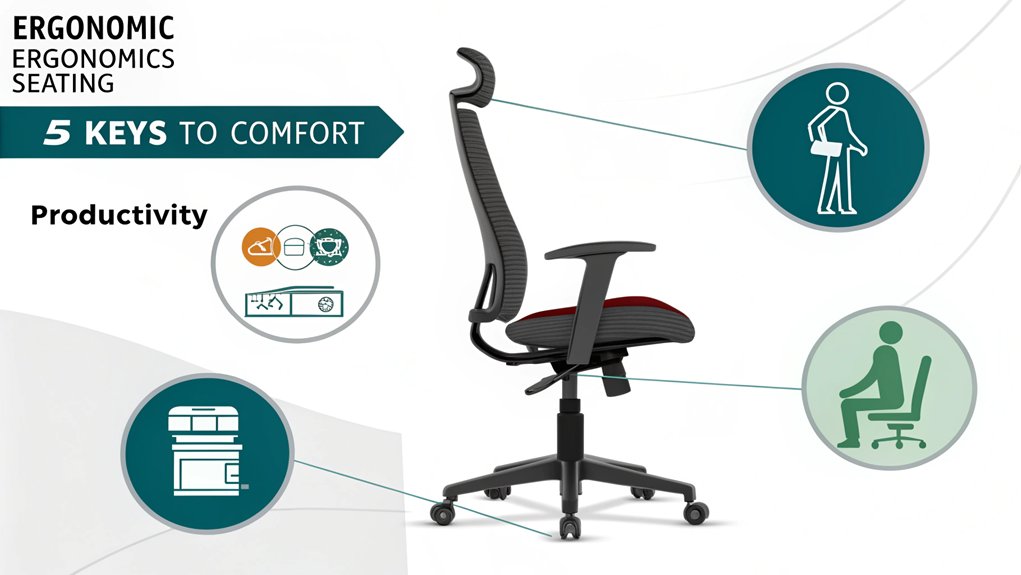
When selecting an ergonomic chair, you’ll need to evaluate the range of adjustment mechanisms that allow for personalized positioning, including seat height, lumbar support, and armrest customization.
A proper ergonomic chair ensures that your legs form 90-degrees while keeping feet planted firmly on the ground for optimal circulation and comfort. The 4D armrests provide multiple positioning options to match your preferred working style. Additionally, proper seat depth is crucial as it allows for ideal thigh support without compromising circulation, which is essential for improved blood flow. The use of quality materials plays a significant role in providing long-lasting comfort and support during your work sessions.
The quality and selection of supportive materials directly impact your comfort and the chair’s longevity, with breathable fabrics and high-density foam providing ideal support during extended work sessions.
Your chair’s adjustability features should work in harmony with carefully chosen materials to create a seating solution that adapts to your body’s unique needs while maintaining its structural integrity over time.
Essential Adjustment Mechanisms
As the foundation of ergonomic seating, essential adjustment mechanisms enable users to customize their chairs for ideal comfort and support throughout the workday.
You’ll find that adjustable lumbar features conform to your spine’s natural curve, while tilt mechanisms promote dynamic movement and balanced support during extended periods of sitting. Since sedentary jobs increased 83% since 1950, these adjustment features have become increasingly vital for workplace well-being. Breathable materials in quality ergonomic chairs ensure optimal temperature regulation during long workdays, making it crucial to choose options like mesh designs that enhance airflow. Additionally, the use of dynamic support systems encourages micro-movements that help prevent stiffness and fatigue.
To optimize your seating experience, focus on configuring key adjustments: set your seat height so your feet rest flat and thighs remain parallel to the ground, position armrests to maintain a 90-degree elbow angle, and utilize the backrest angle controls to achieve proper spinal alignment.
Advanced tilt options, including synchro and multi-function mechanisms, allow you to shift smoothly between postures, reducing muscle fatigue and enhancing circulation while maintaining ergonomic positioning.
Supportive Material Selection
The selection of appropriate materials plays a crucial role in determining an ergonomic chair’s overall effectiveness and user comfort.
You’ll find that material durability varies markedly across options: leather offers long-lasting resilience, while mesh provides superior breathability for warmer environments.
Consider your comfort preferences when choosing between fabric’s everyday practicality and leather’s luxurious feel.
Your workspace climate should influence your selection, as mesh and fabric promote better air circulation in warm settings. Additionally, the right materials can significantly improve productivity by allowing you to focus on your tasks without discomfort. Ergonomic furniture with properly designed materials can help reduce mechanical stress on joints, tendons, and ligaments.
For ideal health benefits, look for materials that support proper posture while meeting your sensory expectations.
Modern ergonomic chairs often combine multiple materials – metal frames for stability, memory foam for support, and breathable upholstery for comfort.
The right material combination can enhance your productivity by maintaining comfort throughout extended work sessions.
Quality materials should include features that promote proper spine alignment to prevent musculoskeletal disorders and chronic pain.
Sustainable practices are increasingly shaping how manufacturers select and source materials for ergonomic chairs.
Health Benefits of Using Ergonomic Office Chairs
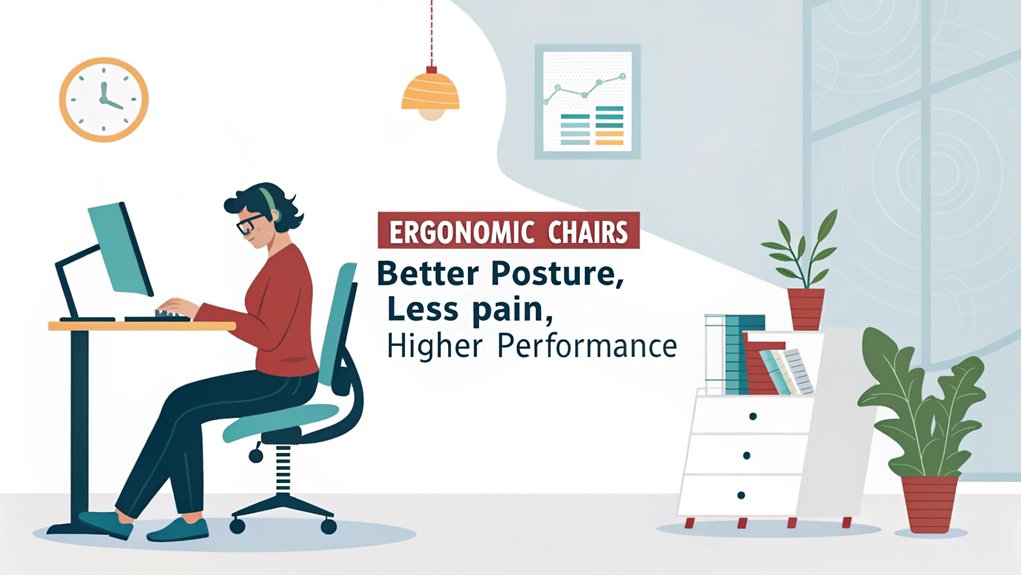
Investing in ergonomic office chairs yields substantial health benefits that extend far beyond basic comfort. The ergonomic advantages include enhanced organ function, reduced musculoskeletal strain, and improved circulatory health through proper posture support. Additionally, ergonomic chairs facilitate optimal body alignment, which is crucial for long periods of sitting. Regular use of ergonomic chairs can also encourage better posture and spinal alignment, further enhancing overall comfort.
You’ll experience significant posture benefits that help prevent long-term spinal degeneration while supporting ideal respiratory function. Extended sitting sessions become more manageable with proper back alignment thanks to ergonomic chairs. The advanced headrest design reduces neck strain by providing optimal support for your head and neck muscles.
Here’s how ergonomic chairs transform your health:
- Boosts cognitive performance by improving blood flow and oxygen delivery to your brain.
- Reduces the risk of developing chronic conditions like deep vein thrombosis and repetitive strain injuries.
- Supports mental well-being by eliminating physical discomfort that contributes to workplace stress.
These evidence-based benefits demonstrate why ergonomic chairs are essential for maintaining peak health and productivity in today’s demanding work environment.
Productivity Gains Through Proper Seating Support
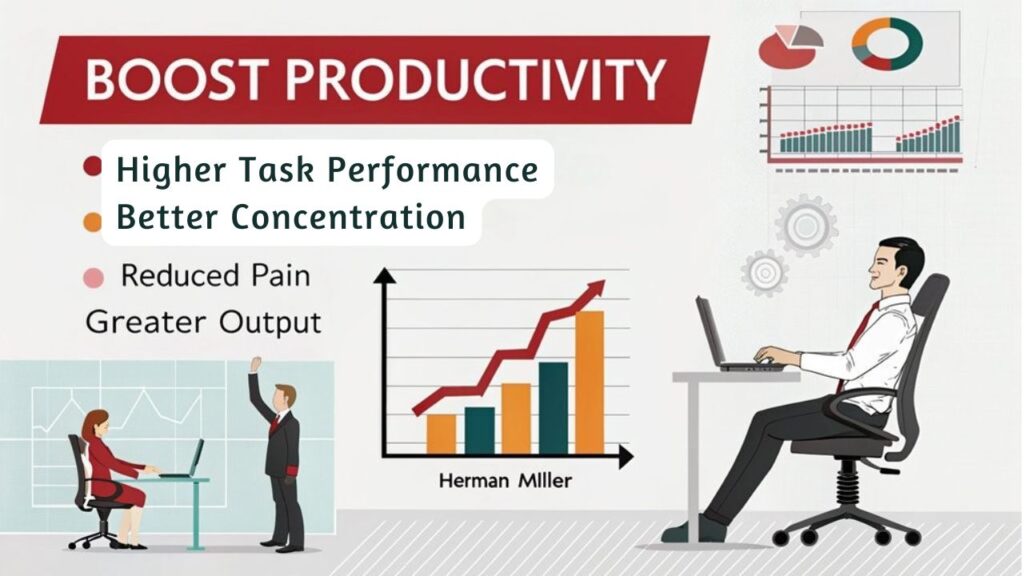
Your ability to maintain peak performance depends heavily on proper seating that enables sustained focus and concentration throughout the workday.
By selecting an ergonomic chair that supports natural movement and postural adjustments, you’ll maintain better mental clarity and cognitive function during complex tasks. Research shows that productivity can increase by up to 40 percent when using proper ergonomic seating. Workers experiencing ergonomic discomfort frequently report increased anxiety and frustration that impacts their work quality. Additionally, implementing lumbar support is crucial for reducing spinal strain, further enhancing overall comfort during extended periods of sitting. A properly selected lumbar support pillow can help restore normal lumbar lordosis, reducing pressure on spinal discs and alleviating back pain.
The right seating solution directly powers your work output by reducing physical strain and fatigue while promoting ideal positioning for sustained productivity.
Focus Drives Peak Performance
When aiming for peak performance at work, proper ergonomic seating plays an essential role in maintaining focus and productivity. Research shows that the right chair, combined with focus techniques and performance enhancement strategies, can markedly improve your cognitive function and work output. Studies indicate that employing chairs with proper lumbar support helps workers maintain optimal posture throughout extended work sessions. The Leap chair’s LiveBack technology provides dynamic spine support that adapts to user movement. Additionally, incorporating standing desks can further enhance overall workspace ergonomics, promoting better health and reducing fatigue. Ergonomic solutions like ergonomic keyboards can also assist in preventing discomfort during long hours of work.
Here’s how ergonomic chairs boost your mental performance:
- Reduced cognitive load through optimal physical support, allowing you to direct more mental energy toward complex tasks.
- Enhanced decision-making speed and accuracy, particularly when using advanced designs like the Cosm chair.
- Improved neural efficiency and distraction management, leading to better concentration in busy work environments.
You’ll experience up to 17.7% increased productivity with ergonomic seating, while proper training maximizes these benefits.
The combination of comfort and support creates an ideal environment for sustained mental performance throughout your workday.
Movement Enhances Mental Clarity
Research demonstrates that movement considerably enhances cognitive function and mental clarity during work hours. When you engage in just 20 minutes of moderate exercise, you’ll experience immediate cognitive enhancement through improved memory, concentration, and problem-solving capabilities. This is particularly important for those in ergonomic work environments, as it ensures that the benefits of movement are fully realized. Additionally, utilizing lumbar support pillows can further improve posture and relieve lower back pain, enhancing your overall comfort while working.
These movement benefits stem from increased BDNF production and enhanced blood flow to your brain. Regular physical activity has been shown to lower cortisol levels, helping employees better manage workplace stress. Studies reveal that ergonomic seating solutions like the Cosm chair contribute to improved neural efficiency during focused work tasks.
To maximize these advantages, integrate walking sessions into your workday, as they specifically boost creative thinking and divergent ideation. You’ll maintain these benefits even after returning to your ergonomic chair.
Posture Powers Work Output
Beyond movement’s cognitive benefits, proper posture serves as a fundamental driver of workplace productivity and performance.
Studies demonstrate that reduced task errors occur when employees maintain proper sitting posture throughout the workday. Ergonomic furniture is essential for achieving this, as it is designed to adapt workplace design to natural body movements. Additionally, the use of ergonomic accessories such as keyboard trays can further enhance comfort and prevent injury by promoting a neutral wrist position during typing.
You’ll experience measurable posture benefits when using ergonomic chairs that support your spine’s natural alignment, dispelling common ergonomic myths about one-size-fits-all solutions.
Research has shown that enhanced comfort levels result from using ergonomic chairs compared to traditional office seating.
Scientific research confirms that proper posture directly impacts your cognitive function and work output through:
- Enhanced blood circulation to the brain, leading to improved mental clarity and focus
- Reduced physical strain and fatigue, allowing sustained concentration on complex tasks
- Optimized spinal alignment that minimizes distractions from discomfort
Economic Impact of Ergonomic Chair Investment
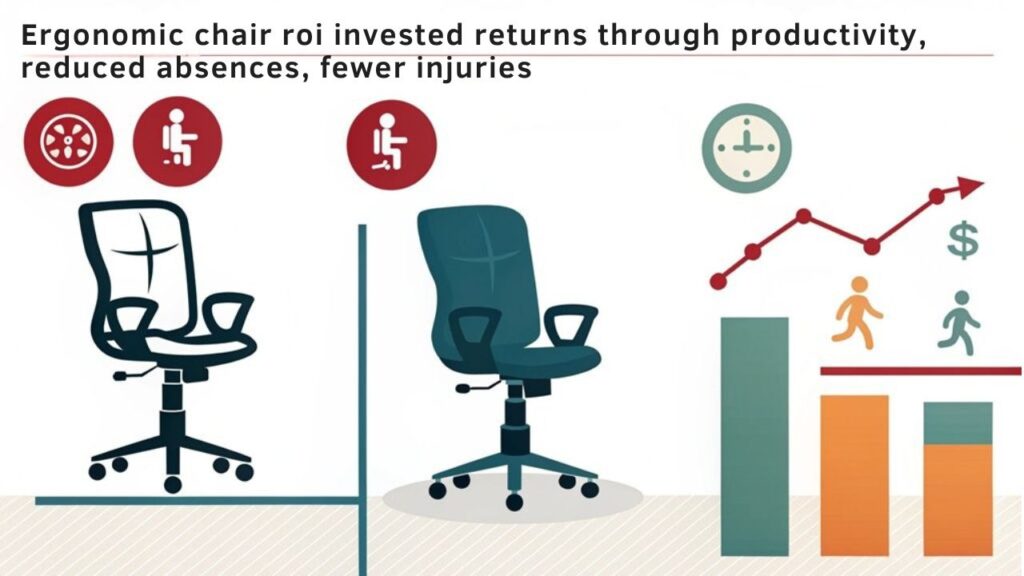
Companies investing in ergonomic chairs experience substantial financial returns through multiple revenue-positive channels. Your organization can achieve measurable economic benefits through reduced healthcare costs, decreased absenteeism, and enhanced workplace efficiency.
Data-driven analysis reveals that the initial investment delivers significant long-term savings by minimizing musculoskeletal disorders and related medical expenses. Investing in ergonomic chairs has been shown to create a vibrant workplace culture that boosts morale. Additionally, the recline feature of ergonomic chairs allows employees to adjust their posture, further reducing spinal pressure and promoting overall well-being. Furthermore, ergonomic solutions like ergonomic keyboards can complement your investment in chairs, creating a holistic approach to workplace comfort and productivity.
You’ll gain a competitive edge in talent acquisition and retention, as ergonomic investments signal your commitment to employee well-being. This translates into lower turnover rates and reduced hiring costs. Studies show that proper lumbar support in ergonomic chairs helps maintain spine health and reduces injury-related expenses.
The indirect financial impact includes improved productivity, increased employee engagement, and enhanced creative output. By conducting a thorough cost-benefit analysis, you can quantify these returns and demonstrate how ergonomic chair investments contribute to your organization’s financial performance and sustainable growth.
Selecting the Right Ergonomic Chair for Your Needs
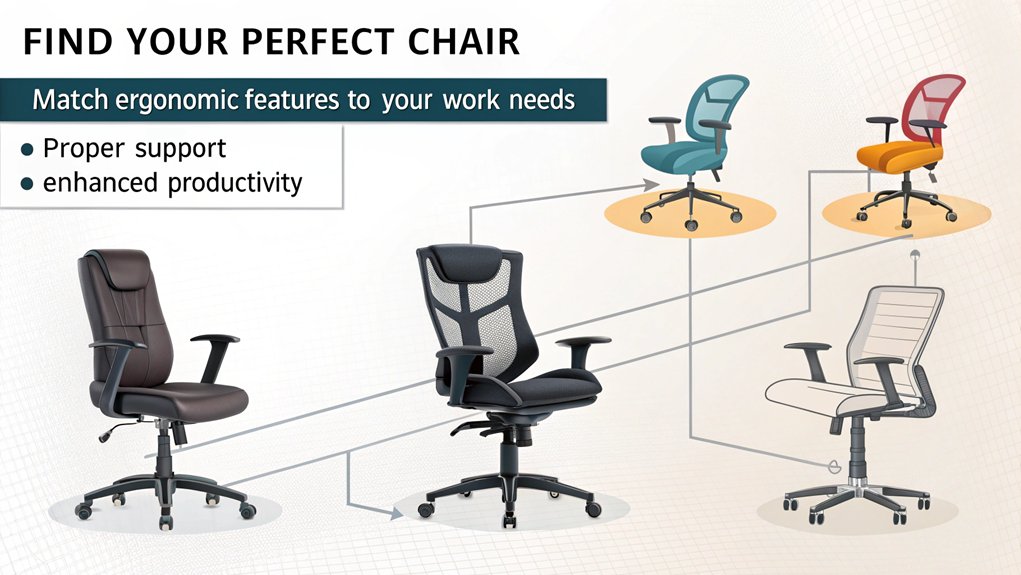
When selecting an ergonomic chair, your decision must align with established standards and key performance features that directly impact workplace comfort and productivity.
Look for chairs that meet ANSI/BIFMA standards and GREENGUARD certification to guarantee both safety and environmental quality.
Consider these critical factors when evaluating chair features against your user preferences:
- Adjustability range – verify that seat height, armrests, and lumbar support accommodate your body measurements.
- Material quality – assess breathability, cushioning density, and durability of construction materials. Mesh backs can enhance airflow, promoting a cooler and more comfortable workspace.
- Testing validation – check expert endorsements and user reviews for real-world performance data.
You’ll want to test the chair personally before purchase, focusing on the contoured seat’s support, backrest positioning, and overall stability during typical work activities.
Setting Up Your Chair for Optimal Performance
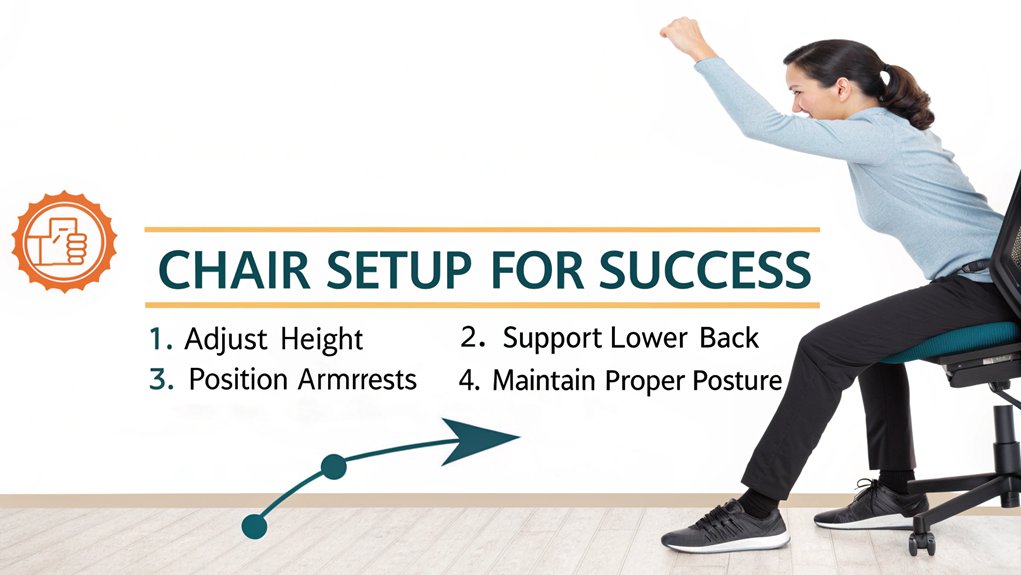
To maximize your ergonomic chair’s benefits, proper setup and adjustment of key components are essential for peak workplace performance.
Begin your chair adjustments by setting the height to maintain 90-degree angles at both your knees and elbows while your feet rest flat. Next, optimize seating comfort by adjusting the seat depth, leaving a two-finger gap between the seat edge and your knees.
Position the lumbar support to align with your lower back’s natural curve, then set your armrests at elbow height with shoulders relaxed.
Fine-tune the backrest tension and seat tilt to support dynamic movement while maintaining proper spinal alignment.
These precise adjustments work together to enhance your posture, reduce strain, and create an ergonomic workspace that promotes sustained productivity and physical well-being.
Maintaining Your Ergonomic Chair’s Effectiveness
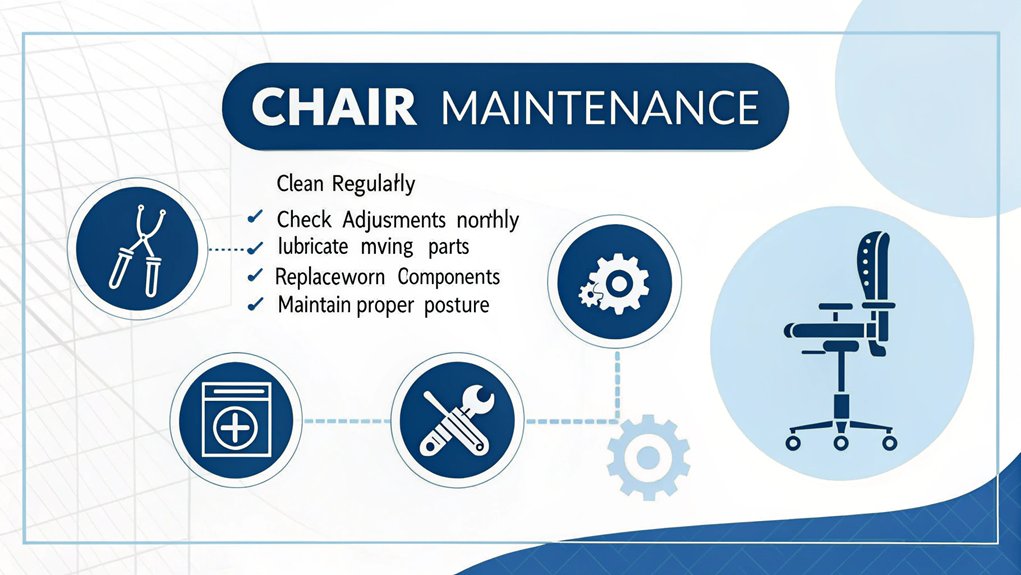
After establishing ideal chair settings, maintaining your ergonomic chair’s performance requires consistent upkeep and monitoring.
Implementing a structured cleaning routine and respecting weight limits will considerably extend your chair’s lifespan while preserving its ergonomic benefits.
For peak chair performance, focus on these critical maintenance areas:
- Conduct weekly inspections of mechanical components, lubricating moving parts and checking for loose connections.
- Clean surfaces with mild solutions to prevent dust accumulation and maintain material integrity.
- Adjust settings regularly to accommodate posture changes and different tasks throughout your workday.
Remember to address wear indicators promptly, such as cushion degradation or unusual noises.
Frequently Asked Questions
How Long Does It Typically Take to Adjust to an Ergonomic Chair?
You’ll need a 2-3 week adjustment period as your body adapts to new posture demands, though your comfort levels will improve gradually with consistent use of proper ergonomic settings.
Can Ergonomic Chairs Help With Existing Chronic Back Pain Conditions?
While ergonomic chairs won’t cure existing back issues, they can provide chronic pain relief through improved seating posture. You’ll experience reduced discomfort when your spine’s properly aligned and supported.
Are Ergonomic Chairs Suitable for People of All Heights and Weights?
You’ll find ergonomic chairs with height adaptability from 15-23 inches and weight capacity ranging 250-400 pounds, ensuring proper support regardless of your body dimensions through customizable features.
How Often Should Ergonomic Chairs Be Replaced for Optimal Performance?
You’ll need to replace your ergonomic chair every 7-8 years based on standard chair lifespan, though replacement frequency may increase with heavy daily use or decrease with proper maintenance.
Do Ergonomic Chairs Require Special Cleaning Methods to Maintain Their Materials?
Like a knight polishing armor, you’ll need specific cleaning materials for different chair components. Follow maintenance tips: vacuum regularly, use gentle cleaners, and condition leather surfaces properly.
Conclusion
Your ergonomic chair stands as a gateway to peak workplace performance, serving as both throne and tool in your professional arsenal. By investing in proper seating, you’re building a foundation for sustained productivity and well-being. Don’t underestimate this silent sentinel of spinal health – it’s your daily launch pad for success. Optimize your workspace with an ergonomic chair that aligns with your body’s needs and watch your efficiency soar.

I am a retired software engineer with experience in a multitude of areas including managing AWS and VMWare development environments. I bought a relative a mini-PC a year ago and have become passionate about the technology and its potential to change how we deploy software.

